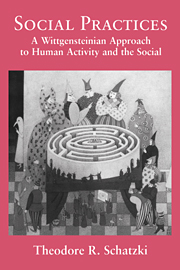Book contents
5 - DIMENSIONS OF PRACTICE THEORY
Published online by Cambridge University Press: 17 September 2009
Summary
Waves of theory have rolled in in recent decades to uproot the rigidity of the venerable opposition between individual and society, as well as the viscous front between subject- and object-oriented schools of thought. The previous chapter, in pushing beyond the ideas on mind/action and social constitution extractable from Wittgenstein's texts, initiated engagement with one prominent such strand of thought, “practice theory.” The present chapter documents the broad convergences and ultimate divergences between my account and the two grandest and most influential analyses of practice, those of Bourdieu and Giddens. Its narration will foster deeper understandings of both the nature of practice and key themes that link practice theories.
One such theme is the consolidation of two of the three notions of practice distinguished early in the previous chapter: practice as spatiotemporal array of linked behaviors and practice as the do-ing of behavior. Animating this consolidation are, first, the realization that practices qua spatiotemporal manifolds only exist through individuals performing the doings and sayings that compose them, and, second, the resulting intuition that these practices and behaviors must somehow be structured alike. The centrality of this consolidation in the analyses of Bourdieu, Giddens, and the previous chapter is evidenced in the prominence they accord to elaborating a structure that at once organizes social practices and governs their constituent performances. Much of the current chapter concerns their divergent accounts of this unifying structure.
- Type
- Chapter
- Information
- Social PracticesA Wittgensteinian Approach to Human Activity and the Social, pp. 133 - 167Publisher: Cambridge University PressPrint publication year: 1996

